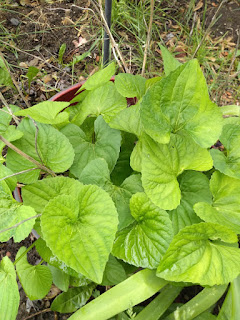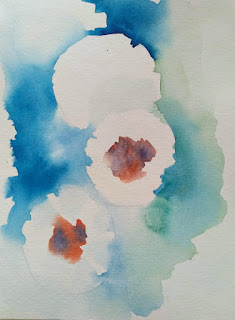I'm back to discussing looser paintings and looking at the work of Jean Haines.
In the last blog I discussed getting to know your subject. And I try to follow my own advice. In the first tries of painting the violets, I did studies of the flower and felt like I was really ready to paint them. BUT I didn't like my leaves. Somehow they looked blobby. And I realized that, while I studied the flower petals, I did not give enough attention to studying the leaves and how they grew. So I began a study of those, and was much happier with the results.
 My leaf reference
My leaf reference
The following exercise puts into practice the things I learned from the violets: allowing colors to merge to create connections; paying attention to lost edges and hard edges. This time I used an idea suggested by Jean Haines to create a background first, and allow parts of it to merge into the foreground. It was also important NOT TO OUTLINE the object of interest, but to allow parts of it to have soft shapes that merge into the background.
First I drew three circles in an arch. This is done on a small sheet of 6 x 8 cold press. I did not try to draw petals, just circles. Using two blues (pthalo and cerulean) I began to paint the background around the circles. YOU CHOOSE WHAT COLORS YOU LOVE. Use it as a chance to experiment with color.
To create petals I just "cut into" the circle shapes to indicate where the petal would be. I did not try to outline all of the flower. I painted some areas dark, some lighter, some not at all.
PLAY with the background: DRIP colors, salt, use plastic wrap, tilt the paper, spatter, whatever sounds fun at the time.

Remember brushing clean water over part of a violet to allow the color to bleed into the background?
This time, before the background is completely dry, take clean water over an edge where a petal meets the background, and let light color bleed into the flower petal. This creates a pale shadow on the petal and begins to create the flower.
**I know I always preach not to paint unless the paper is completely wet or completely dry. This is an exception to the rule. The paint will be dry enough to sink into the paper, lost its shine, but still not completely settled so that you can pull some off to create a soft edge.
You can see this on the top right petal of the top flower. Look at the flowers for edges that seem to merge into the background.
For the centers, choose a color that contrasts with background.
Below I just played with pinks.




No comments:
Post a Comment